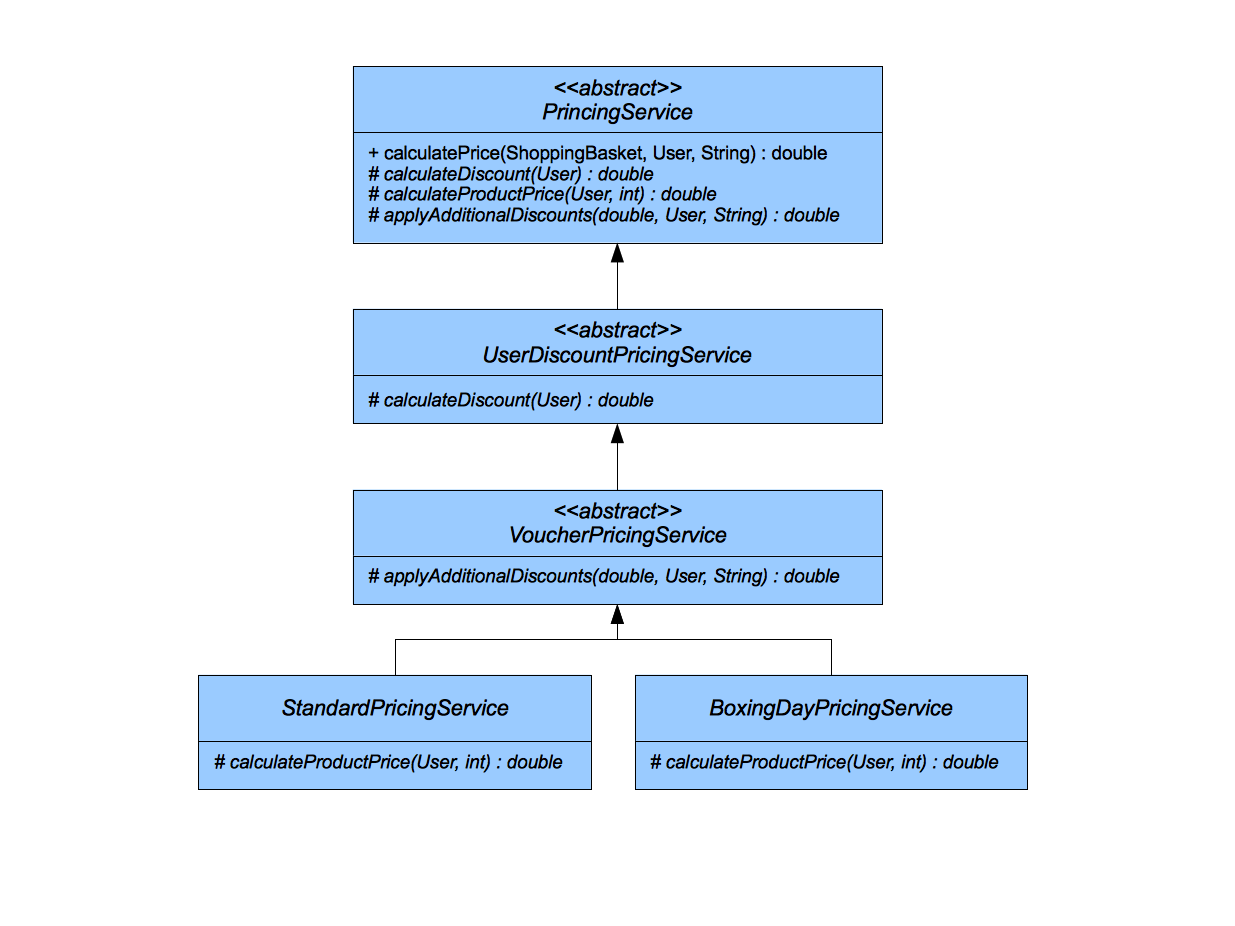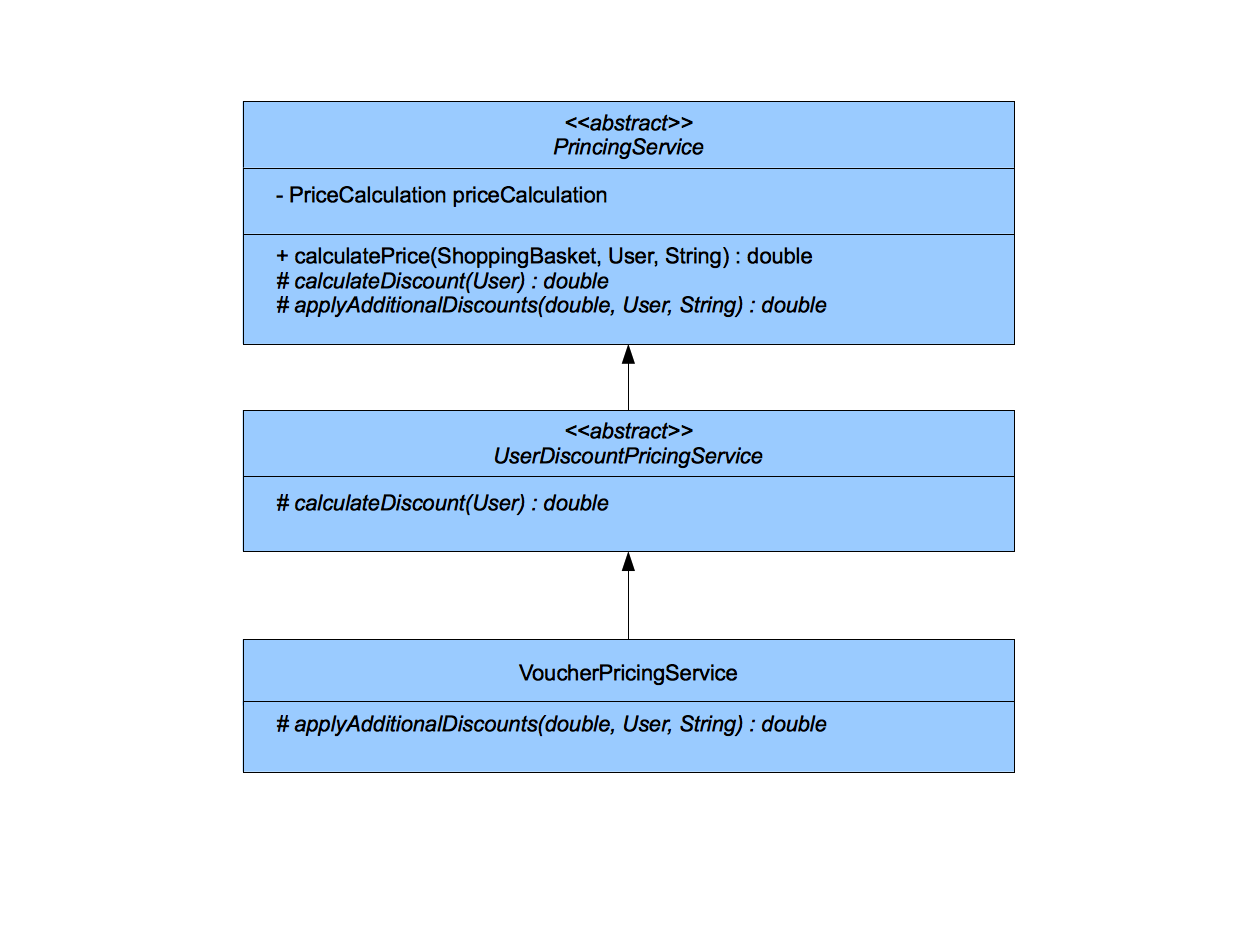
- Por Sandro Mancuso
- ·
- Publicado 26 Mar 2012
In part 1 of this post I explain the problems of using the template method in deep class hierarchies and how I went to solve it. Please read it before reading this post.
Here is a more concrete example in how to break deep hierarchies using the Extract, Inject, Kill approach. Imagine the following hierarchy.
public abstract class PrincingService {
public double calculatePrice(ShoppingBasket shoppingBasket, User user, String voucher) {
double discount = calculateDiscount(user);
double total = 0;
for (ShoppingBasket.Item item : shoppingBasket.items()) {
total += calculateProductPrice(item.getProduct(), item.getQuantity());
}
total = applyAdditionalDiscounts(total, user, voucher);
return total * ((100 - discount) / 100);
}
protected abstract double calculateDiscount(User user);
protected abstract double calculateProductPrice(Product product, int quantity);
protected abstract double applyAdditionalDiscounts(double total, User user, String voucher);
}
public abstract class UserDiscountPricingService extends PrincingService {
@Override
protected double calculateDiscount(User user) {
int discount = 0;
if (user.isPrime()) {
discount = 10;
}
return discount;
}
}
public abstract class VoucherPrincingService extends UserDiscountPricingService {
private VoucherService voucherService;
@Override
protected double applyAdditionalDiscounts(double total, User user, String voucher) {
double voucherValue = voucherService.getVoucherValue(voucher);
double totalAfterValue = total - voucherValue;
return (totalAfterValue > 0) ? totalAfterValue : 0;
}
public void setVoucherService(VoucherService voucherService) {
this.voucherService = voucherService;
}
}
public class BoxingDayPricingService extends VoucherPrincingService {
public static final double BOXING_DAY_DISCOUNT = 0.60;
@Override
protected double calculateProductPrice(Product product, int quantity) {
return ((product.getPrice() * quantity) * BOXING_DAY_DISCOUNT);
}
}
public class StandardPricingService extends VoucherPrincingService {
@Override
protected double calculateProductPrice(Product product, int quantity) {
return product.getPrice() * quantity;
}
}
 Let's start with the StandardPricingService. First, let's write some tests:
Let's start with the StandardPricingService. First, let's write some tests:
public class StandardPricingServiceTest {
private TestableStandardPricingService standardPricingService = new TestableStandardPricingService();
@Test public void
should_return_product_price_when_quantity_is_one() {
Product book = aProduct().costing(10).build();
double price = standardPricingService.calculateProductPrice(book, 1);
assertThat(price, is(10D));
}
@Test public void
should_return_product_price_multiplied_by_quantity() {
Product book = aProduct().costing(10).build();
double price = standardPricingService.calculateProductPrice(book, 3);
assertThat(price, is(30D));
}
@Test public void
should_return_zero_when_quantity_is_zero() {
Product book = aProduct().costing(10).build();
double price = standardPricingService.calculateProductPrice(book, 0);
assertThat(price, is(0D));
}
private class TestableStandardPricingService extends StandardPricingService {
@Override
protected double calculateProductPrice(Product product, int quantity) {
return super.calculateProductPrice(product, quantity);
}
}
}
Note that I used a small trick here, extending the StandardPricingService class inside the test class so I could have access to the protected method. We should not use this trick in normal circumstances. Remember that if you feel the need to test protected or private methods, it is because your design is not quite right, that means, there is a domain concept missing in your design. In other words, there is a class crying to come out from the class you are trying to test.
Now, let's do the step one in our Extract, Inject, Kill strategy. Extract the content of the calculateProductPrice() method into another class called StandardPriceCalculation. This can be done automatically using IntelliJ or Eclipse. After a few minor adjusts, that's what we've got.
public class StandardPriceCalculation {
public double calculateProductPrice(Product product, int quantity) {
return product.getPrice() * quantity;
}
}
And the StandardPriceService now looks like this:
public class StandardPricingService extends VoucherPrincingService {
private final StandardPriceCalculation standardPriceCalculation = new StandardPriceCalculation();
@Override
protected double calculateProductPrice(Product product, int quantity) {
return standardPriceCalculation.calculateProductPrice(product, quantity);
}
}
All your tests should still pass.
As we create a new class, let's add some tests to it. They should be the same tests we had for the StandardPricingService.
public class StandardPriceCalculationTest {
private StandardPriceCalculation priceCalculation = new StandardPriceCalculation();
@Test public void
should_return_product_price_when_quantity_is_one() {
Product book = aProduct().costing(10).build();
double price = priceCalculation.calculateProductPrice(book, 1);
assertThat(price, is(10D));
}
@Test public void
should_return_product_price_multiplied_by_quantity() {
Product book = aProduct().costing(10).build();
double price = priceCalculation.calculateProductPrice(book, 3);
assertThat(price, is(30D));
}
@Test public void
should_return_zero_when_quantity_is_zero() {
Product book = aProduct().costing(10).build();
double price = priceCalculation.calculateProductPrice(book, 0);
assertThat(price, is(0D));
}
}
Great, one sibling done. Now let's do the same thing for the BoxingDayPricingService.
public class BoxingDayPricingServiceTest {
private TestableBoxingDayPricingService boxingDayPricingService = new TestableBoxingDayPricingService();
@Test public void
should_apply_boxing_day_discount_on_product_price() {
Product book = aProduct().costing(10).build();
double price = boxingDayPricingService.calculateProductPrice(book, 1);
assertThat(price, is(6D));
}
@Test public void
should_apply_boxing_day_discount_on_product_price_and_multiply_by_quantity() {
Product book = aProduct().costing(10).build();
double price = boxingDayPricingService.calculateProductPrice(book, 3);
assertThat(price, is(18D));
}
private class TestableBoxingDayPricingService extends BoxingDayPricingService {
@Override
protected double calculateProductPrice(Product product, int quantity) {
return super.calculateProductPrice(product, quantity);
}
}
}
Now let's extract the behaviour into another class. Let's call it BoxingDayPricingCalculation.
public class BoxingDayPriceCalculation {
public static final double BOXING_DAY_DISCOUNT = 0.60;
public double calculateProductPrice(Product product, int quantity) {
return ((product.getPrice() * quantity) * BOXING_DAY_DISCOUNT);
}
}
The new BoxingDayPriceService is now
public class BoxingDayPricingService extends VoucherPrincingService {
private final BoxingDayPriceCalculation boxingDayPriceCalculation = new BoxingDayPriceCalculation();
@Override
protected double calculateProductPrice(Product product, int quantity) {
return boxingDayPriceCalculation.calculateProductPrice(product, quantity);
}
}
We now need to add the tests for the new class.
public class BoxingDayPriceCalculationTest {
private BoxingDayPriceCalculation priceCalculation = new BoxingDayPriceCalculation();
@Test public void
should_apply_boxing_day_discount_on_product_price() {
Product book = aProduct().costing(10).build();
double price = priceCalculation.calculateProductPrice(book, 1);
assertThat(price, is(6D));
}
@Test public void
should_apply_boxing_day_discount_on_product_price_and_multiply_by_quantity() {
Product book = aProduct().costing(10).build();
double price = priceCalculation.calculateProductPrice(book, 3);
assertThat(price, is(18D));
}
}
Now both StandardPricingService and BoxingDayPricingService have no implementation of their own. The only thing they do is to delegate the price calculation to StandardPriceCalculation and BoxingDayPriceCalculation respective. Both price calculation classes have the same public method, so now let's extract a PriceCalculation interface and make them both implement it.
public interface PriceCalculation {
double calculateProductPrice(Product product, int quantity);
}
public class BoxingDayPriceCalculation implements PriceCalculation
public class StandardPriceCalculation implements PriceCalculation
Awesome. We are now ready for the Inject part of Extract, Inject, Kill approach. We just need to inject the desired behaviour into the parent (class that defines the template method). The calculateProductPrice() is defined in the PricingService, the class at the very top at the hierarchy. That's where we want to inject the PriceCalculation implementation. Here is the new version:
public abstract class PricingService {
private PriceCalculation priceCalculation;
public double calculatePrice(ShoppingBasket shoppingBasket, User user, String voucher) {
double discount = calculateDiscount(user);
double total = 0;
for (ShoppingBasket.Item item : shoppingBasket.items()) {
total += priceCalculation.calculateProductPrice(item.getProduct(), item.getQuantity());
}
total = applyAdditionalDiscounts(total, user, voucher);
return total * ((100 - discount) / 100);
}
protected abstract double calculateDiscount(User user);
protected abstract double applyAdditionalDiscounts(double total, User user, String voucher);
public void setPriceCalculation(PriceCalculation priceCalculation) {
this.priceCalculation = priceCalculation;
}
}
Note that the template method calculateProductPrice() was removed from the PricingService, since its behaviour is now being injected instead of implemented by sub-classes.
As we are here, let's write some tests for this last change, checking if the PricingService is invoking the PriceCalculation correctly.
Great. Now we are ready for the last bit of the Extract, Inject, Kill refactoring. Let's kill both StandardPricingService and BoxingDayPricingService child classes.
The VoucherPricingService, now the deepest class in the hierarchy, can be promoted to concrete class. Let's have another look at the hierarchy:
 And that's it. Now it is just to repeat the same steps for VoucherPricingService and UserDiscountPricingService. Extract the implementation of their template methods into classes, inject them into PricingService, and kill the classes.
And that's it. Now it is just to repeat the same steps for VoucherPricingService and UserDiscountPricingService. Extract the implementation of their template methods into classes, inject them into PricingService, and kill the classes.
In doing so, every time you extract a class, try to give them proper names instead of calling them Service. Suggestions could be VoucherDiscountCalculation and PrimeUserDiscountCalculation.
There were a few un-safe steps in the re-factoring described above and I also struggled a little bit to describe exactly how I did it since I was playing quite a lot with the code. Suggestions and ideas are very welcome.
For the final solution, please check the last part of this blog post.
NOTE If you are not used to use builders in your tests and is asking yourself where the hell aProduct() and aShoppingBasket() come from, check the code in here:
For more information about the original problem that triggered all this, please read part 1 of this blog post.
In part 3 I finish the exercise, breaking the entire hierarchy. Please have a look at it for the final solution.



Software es nuestra pasión.
Somos Software Craftspeople. Construimos software bien elaborado para nuestros clientes, ayudamos a los/as desarrolladores/as a mejorar en su oficio a través de la formación, la orientación y la tutoría. Ayudamos a las empresas a mejorar en la distribución de software.